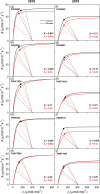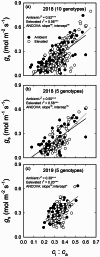Bioenergy sorghum maintains photosynthetic capacity in elevated ozone concentrations
- PMID: 33245145
- PMCID: PMC7986789
- DOI: 10.1111/pce.13962
Bioenergy sorghum maintains photosynthetic capacity in elevated ozone concentrations
Abstract
Elevated tropospheric ozone concentration (O3 ) significantly reduces photosynthesis and productivity in several C4 crops including maize, switchgrass and sugarcane. However, it is unknown how O3 affects plant growth, development and productivity in sorghum (Sorghum bicolor L.), an emerging C4 bioenergy crop. Here, we investigated the effects of elevated O3 on photosynthesis, biomass and nutrient composition of a number of sorghum genotypes over two seasons in the field using free-air concentration enrichment (FACE), and in growth chambers. We also tested if elevated O3 altered the relationship between stomatal conductance and environmental conditions using two common stomatal conductance models. Sorghum genotypes showed significant variability in plant functional traits, including photosynthetic capacity, leaf N content and specific leaf area, but responded similarly to O3 . At the FACE experiment, elevated O3 did not alter net CO2 assimilation (A), stomatal conductance (gs ), stomatal sensitivity to the environment, chlorophyll fluorescence and plant biomass, but led to reductions in the maximum carboxylation capacity of phosphoenolpyruvate and increased stomatal limitation to A in both years. These findings suggest that bioenergy sorghum is tolerant to O3 and could be used to enhance biomass productivity in O3 polluted regions.
Keywords: BWB model; MED model; biomass; chlorophyll fluorescence; photosynthesis; stomatal conductance.
© 2020 The Authors. Plant, Cell & Environment published by John Wiley & Sons Ltd.
Conflict of interest statement
The authors declare no conflicts of interest.
Figures








References
-
- Ainsworth, E. A. (2017). Understanding and improving global crop response to ozone pollution. Plant Journal, 90, 886–897. - PubMed
-
- Ainsworth, E. A. , & Long, S. P. (2005). What have we learned from 15 years of free‐air CO2 enrichment (FACE)? A meta‐analytic review of the responses of photosynthesis, canopy properties and plant production to rising CO2 . New Phytologist, 165, 351–372. - PubMed
-
- Ainsworth, E. A. , Rogers, A. , Nelson, R. , & Long, S. P. (2004). Testing the “source‐sink” hypothesis of down‐regulation of photosynthesis in elevated [CO2] in the field with single gene substitutions in Glycine max . Agricultural and Forest Meteorology, 122, 85–94.
-
- Ainsworth, E. A. , Yendrek, C. R. , Sitch, S. , Collins, W. J. , & Emberson, L. D. (2012). The effects of tropospheric ozone on net primary productivity and implications for climate change. Annual Review of Plant Biology, 63, 637–661. - PubMed
Publication types
MeSH terms
Substances
LinkOut - more resources
Full Text Sources
Other Literature Sources
Medical
Miscellaneous

